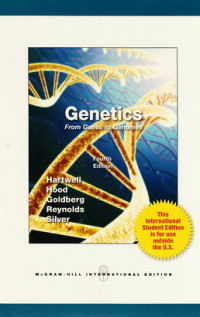Text
Genetics : from genes to genomes
The science of genetics is less than 150 years old, but its accomplishments within that short time have been aston¬ishing. Gregor Mendel first described genes as abstract units of inheritance in 1865; his work was ignored and then "rediscovered" in 1900. Thomas Hunt Morgan and his students provided experimental verification of the idea that genes reside within chromosomes during the years 1910-1920. By 1944, Oswald Avery and his coworkers had established that genes are made of DNA. James Watson and Francis Crick published their pathbreaking structure of DNA in 1953. Remarkably, less than 50 years later (in 2001), an international consortium of investiga¬tors deciphered the sequence of the 3 billion nucleotides in the human genome. Twentieth century genetics made it possible to identify individual genes and to understand a great deal about their functions.
Today, scientists are able to access the enormous amounts of genetic data generated by the sequencing of many organisms' genomes. Analysis of these data will result in a deeper understanding of the complex molecu¬lar interactions within and among vast networks of genes, proteins, and other molecules that help bring organisms to life. Finding new methods and tools for analyzing these data will be a significant part of genetics in the twenty-first century.
Our fourth edition of Genetics: From Genes to Genomes emphasizes both the core concepts of genetics and the cutting-edge discoveries, modern tools, and ana¬lytic methods that will keep the science of genetics moving forward.
Ketersediaan
Informasi Detail
- Judul Seri
-
-
- No. Panggil
-
576 Har g
- Penerbit
- New York : Mc Graw-Hill., 2011
- Deskripsi Fisik
-
xxii, 794 hal. : il. ; 28 cm.
- Bahasa
-
English
- ISBN/ISSN
-
9780071221924
- Klasifikasi
-
576
- Tipe Isi
-
-
- Tipe Media
-
-
- Tipe Pembawa
-
-
- Edisi
-
Ed. IV
- Subjek
- Info Detail Spesifik
-
-
- Pernyataan Tanggungjawab
-
-
Versi lain/terkait
Tidak tersedia versi lain
Lampiran Berkas
Komentar
Anda harus masuk sebelum memberikan komentar

 Karya Umum
Karya Umum  Filsafat
Filsafat  Agama
Agama  Ilmu-ilmu Sosial
Ilmu-ilmu Sosial  Bahasa
Bahasa  Ilmu-ilmu Murni
Ilmu-ilmu Murni  Ilmu-ilmu Terapan
Ilmu-ilmu Terapan  Kesenian, Hiburan, dan Olahraga
Kesenian, Hiburan, dan Olahraga  Kesusastraan
Kesusastraan  Geografi dan Sejarah
Geografi dan Sejarah